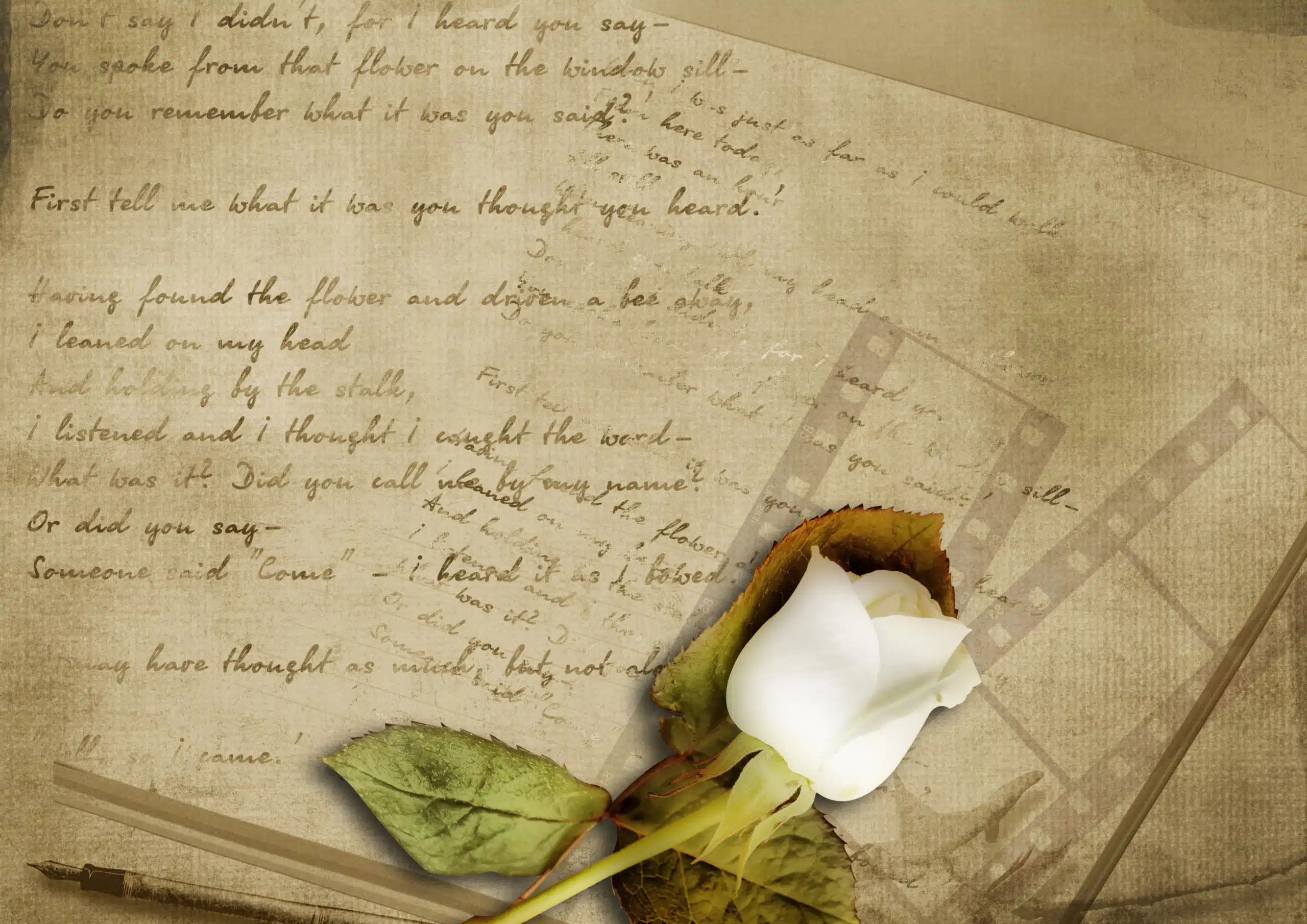Here’s what the Triolet poetry form is:
A triolet is a French poem that consists of eight lines utilizing the ABaAabAB rhyming scheme.
This poem type is called triolet because the first line is repeated thrice.
Triolet poems were most likely invented in medieval 13th-century France.
So if you want to learn all about the Triolet poetry type, then you’ve come to the right place.
Keep reading!
- Rondelet Poetry Form: Charm in Repetition
- Lai Poetry Form: Unveil Heart’s Whispers
- Dansa Poetry Form: Step Into Verse’s Walt
- Ballad Poetry Form: Evoke Sentimental Rhythms

Forms of Poetry: The Triolet

Triolets are a fairly rare form of poetry that has experienced quite a bit of variety in its forms over the years, mainly because it simply didn’t have a concrete identity for a few centuries.
Despite their unpopularity, triolets do have an interesting heritage as a form of court song that evolved into a formal poem, with a short stopover as a favored propaganda tool for a few years in 17th-century France.
Basic Properties of Triolet Poems

| Rhyme structure | Strict, with refrains |
| Meter | Strict, with refrains |
| Origin | 13th-century France |
| Popularity | Rare, but they have popped up in various languages |
| Theme | Varies |
How Are Triolets Structured?

The triolet has gone through a few permutations over its lifetime, but the most common variant is an eight-line poem that hinges on the use of refrains and only two end sounds.
The rhyme scheme for this variant is ABaAabAB, in which the capital letters represent the repeated lines.
Triolets in English have commonly been in iambic tetrameter, while French triolets use a combination of tetrameter and trimeter.
Specifically, the second, sixth and eighth lines (each line of the second end sound) tend to be in iambic trimeter followed by a single amphibrachic foot.
Take note that the meter is the main factor that has had variations, both from language to language as well as from time period to time period.
The opening and ending couplets in a triolet are the same due to the refrain structure, leading to a unique case of a poem essentially ending where it started, though the meaning of those lines may shift depending on how the writer contextualizes them.
Example of a Triolet

How Great My Grief by Thomas Hardy
How great my grief, my joys how few,
Since first it was my fate to know thee!
-Have the slow years not brought to view
How great my grief, my joys how few,
Nor memory shaped old times anew,
Nor loving-kindness helped to show thee
How great my grief, my joys how few,
Since first it was my fate to know thee?
The main takeaway here is the use of refrains.
Due to the extreme dependence on repetition, triolets only actually have five original lines, with nearly half of the poem taken up by refrains.
This forces the poet to treat each line as a critical piece of the puzzle since there is no room for wasted words.
Hardy uses those words expertly, making sure to use powerful phrases on each and every line that have instantly recognizable meanings.
Phrases like “my joys how few” and “slow years” hammer in a tone of defeat and frustration that permeates the poem.
Take note that the repeated couplet goes from an expletive at the beginning to a question at the end.
The speaker begins by declaring that he has known few joys and great grief, before trailing off into a question form of the exact same lines in which the meaning takes a slight turn.
History of Triolets

The earliest known triolets come from the 13th century, in which triolets were simply referred to as songs.
Many of the French forms of poetry, including triolets, come from a tradition of poems that were written to be sung with musical accompaniment.
The triolet is most closely related to the French rondeau and its relatives, French forms that heavily utilize refrains.
In fact, the triolet did not properly receive its name for quite some time and was instead referred to as songs or occasionally rondels.
It was near the end of the 15th century that Octavien de Saint-Gelais finally termed this form the triolet, giving it an identity that it had been wanting for two centuries.
While some usages of rondel or rondelet could still be caught in subsequent decades, triolet did become the prevailing term.
Triolets experienced a sudden surge in popularity during 17th century France and were even used politically around the middle of the century during a period of civil unrest.
This popularity would be short-lived, though the form has certainly never died out.
Speaking of the 17th century, this was when the triolet finally made the leap into English at the hands of Patrick Cary.

Cary’s poems were unfortunately published posthumously, so the form’s proper introductions instead came in the form of translations of foreign poems, as is often the case.
The late 19th century marks the introduction of triolets written in English for English audiences by Robert Bridges.
Triolets until now had been largely seen as exclusively a French form.
As with its time in France, triolets experienced a brief surge in popularity, this time internationally, but did not stick.
Triolets have been written in various languages throughout history but remain a relatively rare form that not many poets show an interest in.
This may be because the form can feel stifling, due to relying heavily on refrains despite its brevity.
Tips for Writing a Triolet

The first thing you need to acknowledge is that there simply will not be enough room to beat around the bush.
You have eight lines to work with, and really only five because of the refrains.
A triolet is a form that demands you make your point and move on with your life.
Make sure the triolet catches its readers’ attention immediately and keeps it.
Every line should feature either a clear meaning or a vivid image that locks the reader in place.
In Hardy’s poem, this came in the form of emotional buzzwords like “fate” and “grief” that instantly demand attention.
The refrains will impede your flow if you don’t choose them carefully, so try to choose versatile phrases that work in multiple contexts.
Keep in mind that the repeated lines represent more than half of the overall poem so it is imperative that they be strong and flexible.
The remaining three lines outside of those are the key to making the poem work.
Each of those unique lines must set up the next refrain to have a slightly different impact than it had previously, ideally, or at the very least must hit hard enough to be a point of interest in the poem.
Short forms like the triolet can be tricky since you’ll find yourself with plenty to say and no space to say it.
You’re going to need to choose the exact phrases and images that get your point across as efficiently as possible, or else the whole poem will fall flat.
If you can master them, you may find that triolets can represent an explosive way to share a thought or feeling.
There’s no way of knowing which forms you will or will not enjoy until you’ve already written them, so I do encourage giving this unpopular form a chance.
Poet’s Note

Another French poetic form, another awkward series of transformations before finally settling on a form.
It’s amazing how flexible French forms were in the medieval era, but it certainly makes pinning down a definition complicated.
Comprehensive Collection of Poetry Forms: Craft Words Into Art

Dare to traverse the entire spectrum of poetic forms, from the commonplace to the extraordinary?
Venture from the quintessential Sonnet to the elusive Mistress Bradstreet stanza, right through to the daunting complexity of Cro Cumaisc Etir Casbairdni Ocus Lethrannaigecht.
For those with a zeal to encounter the full breadth of poetry’s forms, this invitation is yours.
Start exploring the vast universe of poetic ingenuity with our comprehensive array of poetry forms right now!
